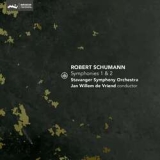Jan Willem de Vriends Schumann aus Stavanger ist rau, kantig, und mit eher kalten Farben etwas ungewohnt. Der Dirigent belebt die Musik der 1. Symphonie mit einem gesunden Rubato, mit Abbremsen und Beschleunigen. Das ergibt affektreiche Gesten, die zu Schumanns Musik passen und dem Hörer interessante Ansätze vermitteln.
Noch interessanter wird die Zweite, die der Komponist als Erinnerung an eine dunkle Zeit bezeichnete. Zwar sind wir noch weit entfernt von den exzentrischen psychischen Extremzuständen, denen Schumann schließlich zum Opfer fallen sollte, aber die finalgewandte Zweite ist eigentlich ein fortwährender Kampf, der die kommende innere Katastrophe zumindest schon andeutet. Das zeigt Jan Willem de Vriends Interpretation des langen ersten Satzes klar und deutlich. Nach dem Scherzo folgt ein Adagio, das durchaus nicht entspannt wirkt, sondern fast ziellos und tastend. In den letzten zwei Minuten scheint sich Schumann zu fangen und aufs Finale zu blicken, das nach einer vielleicht zu langen Pause zwischen beiden Sätzen aufgeregt losbricht und immer wieder durchhängt, ehe endlich Licht am Ende des Tunnels erscheint.
Der Klang des Orchesters aus Stavanger ist durchwegs reich und sonor. De Vriend bringt sein historisches Verständnis gut in die Orchesterpalette ein.
Jan Willem de Vriend’s Schumann from Stavanger is rough, edgy and somewhat unusual with rather cold colors. The conductor enlivens the music of the 1st Symphony with a healthy rubato, with slowing down and speeding up. This results in emotional gestures that suit Schumann’s music and provide the listener with interesting approaches.
Even more interesting is the Second, which the composer described as a reminder of a dark time. Although we are still a long way from the eccentric psychological extremes to which Schumann would eventually fall victim, the Second is actually an ongoing struggle that at least foreshadows the coming inner catastrophe. Jan Willem de Vriend’s interpretation of the long first movement shows this clearly. The Scherzo is followed by an Adagio that does not seem at all relaxed, but almost aimless and groping. In the last two minutes, Schumann seems to catch himself and look towards the finale, which, after a perhaps too long pause between the two movements, breaks out excitedly and sags again and again before light finally appears at the end of the tunnel.
The sound of the orchestra from Stavanger is rich and sonorous throughout. De Vriend brings his historical understanding to the orchestral palette.
























